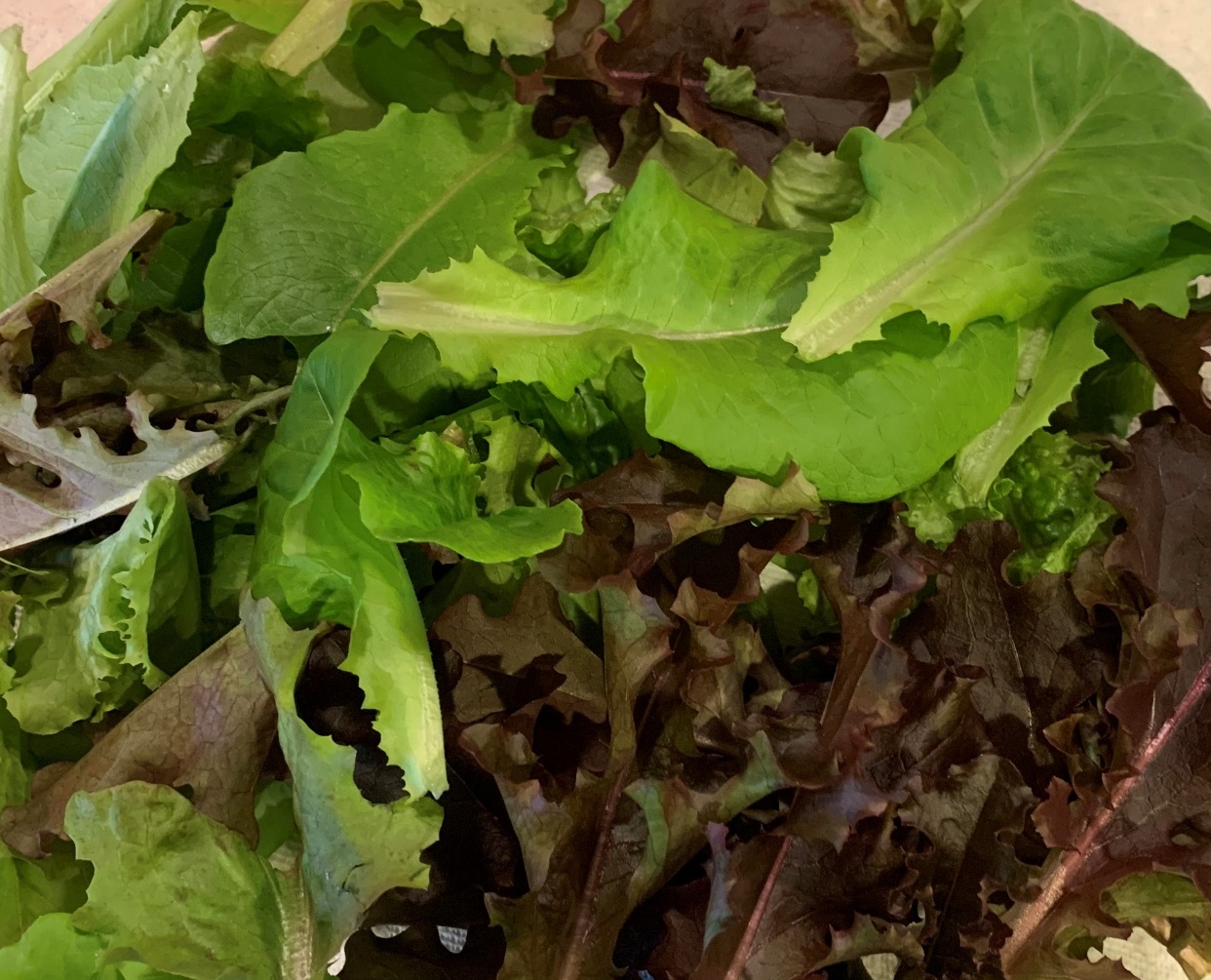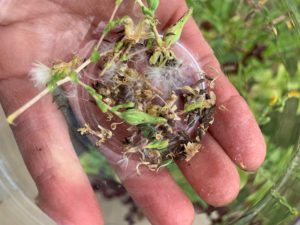Lettuce may not be the first thing that comes to mind when you think about what to plant in your garden, but maybe it should be. This low calorie veggie is not only a good source of dietary fiber, it’s also full of vitamins like A, K and C, as well as, potassium and minerals.
Lettuce is quick and easy to grow with some varieties ready to harvest in as little as four weeks! While lettuce does not like warm temperatures, you can still plant both spring and fall crops in most growing zones in the Untied States.
Container and Soil Type
Lettuce puts down shallow roots, so save your larger containers for something else like zucchini. Small pots of all shapes and sizes work well with lettuce. Some will be large enough to accommodate more than one head, particularly if you practice the “cut and come again” method of harvesting. (see Harvest)
I often grow mesclun baby greens in the same 3.5″ x 3.5″ x 4″ pots I start them in as seed. When it comes time, I simply move them outdoors without bothering to transplant them into another container. They grow beautifully!
This article contains affiliate links. If you make a purchase using one of these links, I will receive a very small commission at no additional cost to you, and it will help me maintain this website. Rest assured, I only recommend products I actually like!
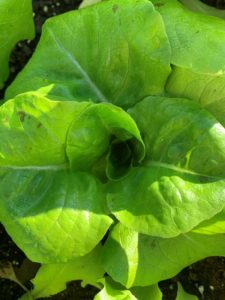
Window boxes are a great way to showcase lettuce, especially if you plant mixed varieties of red, green and variegated lettuce with different textures and leaf structure. Who says greens can’t be as lovely as flowers!
One of my favorite ways to grow lettuce is to plant them underneath taller plants. It’s like getting a bonus crop because you don’t use any extra space, and, as you know, space is a valuable commodity in any garden.
Lettuce will thrive in an organic potting mix that is loose and drains well and has a pH level between 6.0 and 7.0.
How to Plant Seeds
Lettuce is considered a cool weather crop that does best in temperatures between 40oF and 75o F, but can tolerate temps a bit lower or higher for short periods.
In the spring, 3 to 4 weeks before your last frost date, you can start seeds indoors under a grow light or in a sunny window that gets six or more hours of bright sunlight.
Once you harden off the young plants, it’s important to know that greens, like lettuce and Swiss chard, can tolerate a light frost. But if your area experiences a cold front with freezing temperatures, you should move them back indoors until it passes or cover them with a plant blanket or row cover.
For a fall and winter crop, sow seeds indoors in the late summer as they will not germinate in soil that is higher than 80o F. Once you harden them off, you may need to provide partial shade from the heat of the sun.
You’ll want to do succession planting, where you start new seeds every two to three weeks. This will ensure you have a steady supply of tasty greens for the entire season.
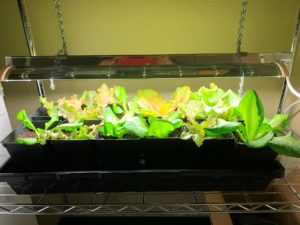
Some lettuce seeds are very small, making it tedious to plant them individually. Instead, try sprinkling them on top of the soil like you would sprinkles on a cupcake, then cover them with a thin layer of soil and moisten well. You can thin them out once the second set of leaves appear.
Light Requirements
Lettuce likes full sun, but if the temperatures rise above 75o F, you may need to place them where they’ll get shade during the hottest part of the day. Alternatively, you can create a makeshift canopy or, better yet, plant them under tall plants, like tomatoes and okra, that will shade them when the sun is overhead.
High temperatures signal the plant to put its efforts into seed production. The leaves will become bitter tasting and the plant will grow a tall stalk that will eventually flower and produce seeds. This is called bolting. The good news is, you can save the seeds to grow next season!
Feed and Water
Feed weekly with an organic water-soluble fertilizer like fish emulsion, which is high in nitrogen. This nutrient is perfect for lettuce because it promotes the growth of a plant’s leaves and not necessarily its fruit. Be sure to follow the package’s instructions.
Keep lettuce seedlings moist, but not soggy. Once established, check to make sure the soil is not drying out. Water thoroughly.
Lettuce Varieties
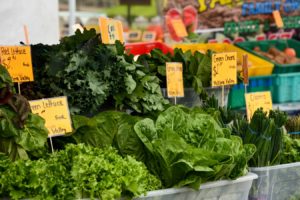
Lettuce can be categorized into four basic types: crisphead, which forms tight heads of crisp leaves; butterhead lettuce which is a smaller, loose head with softer leaves; loose leaf, which doesn’t form a true head and grows quickly; romaine which is more cylindrical in shape with tight-fitting leaves. It’s thought to be the “sweetest” of the lettuce varieties.
Pollination
Since lettuce isn’t a fruit-bearing plant, there is no need for pollination, unless, of course, you allow the plant to bolt for the purpose of collecting seed. So tell those bees to buzz on over to your cucumber and zucchini plants where they are needed!
Harvest
The great thing about lettuce is that once the plant is 2″ to 4″ tall, you can begin to harvest the outer leaves, leaving the inner to continue to grow. This method of harvesting is called “cut and come again,” and it’s a good way to extend your harvest. You should be able to harvest in this manner three or more times before the taste becomes bitter.
Lettuces that form heads, such as romaine and crisphead, can be cut off about two inches above the soil so they can rejuvenate. Or you can cut them off at the soil line if you want to harvest the entire head. Note, however, that the plant will not regenerate. Be sure to harvest lettuce before they exceed the optimum size listed on the seed package or they will taste bitter.
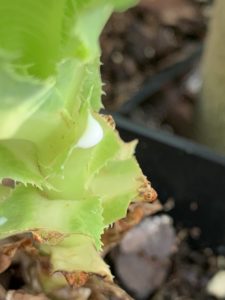
The best time to harvest lettuce is in the morning when the leaves are cool and tender. However, I often wait to harvest lettuce until its needed, right before a meal. There’s nothing like fresh greens and cucumbers right out of the garden!
Lettuce will release a milk-like sap when it’s cut bearing witness to its Latin name Lactuca (lettuce), which is derived from the Latin root word lac or milk.
If the lettuce has grown a tall center stalk, it means it’s bolting or going into seed production mode. It’s time to remove the plant and put it in your compost bin.
Seed Collecting
Make sure the plant you want to harvest seeds from is an heirloom variety. Allow the lettuce to bolt and flower. Once the flowers have been pollinated, they will close back up. Wait until the closed flowers begin to reopen, exposing fibers or fuzz (much like a dandelion). Once the seed heads are completely dry, remove them from the stem. To dislodge the seeds from the head, massage it between your fingertips over a plate or bowl to catch the material. Or you can place the seed heads in a sealed plastic bag and massage them through the bag. Separate the seeds from the other material and store them in a cool, dry, dark place, otherwise, they may grow mold. Do not save seeds from plants that have been infected by a fungus or bacteria. You can learn more about how to successfully and easily save seeds in this helpful article.
Pests
Aphids are soft-bodied insects that colonize and can literally suck the life out of your plants. You can read more about them in my article.
Leafhoppers are interesting looking wedge-shaped insects that come in a variety of colors, including green and brown. They hop or fly away whenever spooked.
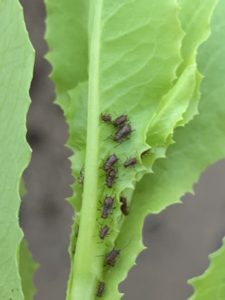
Like aphids, leafhoppers cause damage by sucking the sap out of plants. You can catch them, if you’re quick, and smash them. If you’re too squeamish for that method, you can also use insecticidal soap, which works best on the nymphs. If that isn’t effective, try neem oil.
Slugs are less of a problem in containers than traditional garden beds. However, these slimy critters with a penchant for tender leaves may come after your container lettuce. The easiest and sometimes most effective way to treat them is to just pick them off when you see them. If that is not to your liking, you can lay coarse substances such as clean, crushed egg shells or coffee grounds that will cause abrasions and ultimately dehydrate the slugs. Caffeine is also said to be toxic to them. Diatomaceous earth, another abrasive substance, can also be sprinkled around the container as well as in it. The downside, however, is that you’ll have to reapply it after you water and after it rains.
If your yard has toads, you’re in luck, as these natural predators of slugs.
Cutworms are the larva stage of night-flying moths. They come in a variety of colors, usually no more than 2″ long. They can wreak havoc with your lettuce crop in no time by eating the stems at or near soil level, hence the name, cutworm.
They hide in the soil during the day and curl up in a “C” shape when not active. But at night, they come out to feed. One way to deter them is to place cardboard collars made from paper towel or toilet paper tubes, around the base of the lettuce, making sure it extends into the soil. You can learn more about how to identify and get rid of cutworms in this article.
Cabbage loopers are the larva stage of night-flying gray moths. These caterpillars are light green with stripes that move in a manner similar to an inchworm. They can do considerable damage by eating ragged holes in leaves in a short period of time. The key is to control them before they get established. If you check your plants early in the morning they’ll be easy to spot and can be picked off and disposed of. You can learn more about how to treat them in my article.
Diseases
Lettuce rot is a fungal disease that first affects the lower leaves that are in contact with the soil before spreading over the entire plant. Like other fungal diseases, they can be hard, if not impossible, to get rid. Thus, prevention is the best option. Avoid over watering and do not plant lettuce in the same soil two years in a row.
Soft rot is a bacterial disease that begins with red to brown water-soak spots located at the ends of the leaves and between the veins. The spots will spread and the lettuce will eventually wilt. There is no cure for soft rot. To prevent this disease, do not over water.
Damping off or Fusarium wilt is a fungal disease that can infect a variety of plants, including lettuce. Follow the link for more information.
Be sure to allow space in your garden for at least a few varieties of lettuce. They are easy to plant, easy to grow, and they are a great way to add that fresh garden taste to any meal.
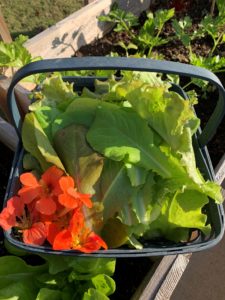
Thank you for reading this article. Please share it via email or social media with others you think might find it helpful.
